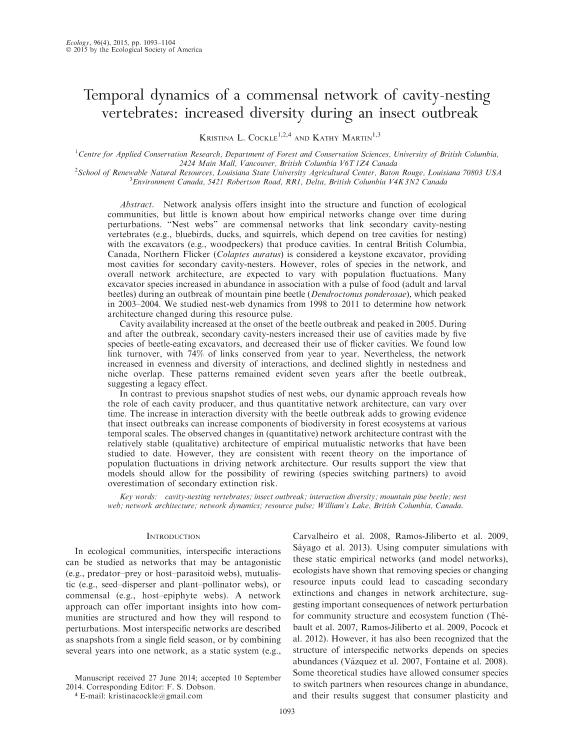Mostrar el registro sencillo del ítem
dc.contributor.author
Cockle, Kristina Louise

dc.contributor.author
Martin, Kathy
dc.date.available
2017-01-16T20:39:03Z
dc.date.issued
2015-04
dc.identifier.citation
Cockle, Kristina Louise; Martin, Kathy; Temporal dynamics of a commensal network of cavity-nesting vertebrates: increased diversity during an insect outbreak; Ecological Society Of America; Ecology; 96; 4; 4-2015; 1093-1104
dc.identifier.issn
0012-9658
dc.identifier.uri
http://hdl.handle.net/11336/11437
dc.description.abstract
Network analysis offers insight into the structure and function of ecological communities, but little is known about how empirical networks change over time during perturbations. ?Nest webs? are commensal networks that link secondary cavity-nesting vertebrates (e.g., bluebirds, ducks, and squirrels, which depend on tree cavities for nesting) with the excavators (e.g., woodpeckers) that produce cavities. In central British Columbia (Canada), Northern Flicker (Colaptes auratus) is considered a keystone excavator, providing most cavities for secondary cavity-nesters. However, roles of species in the network, and overall network architecture, are expected to vary with population fluctuations. Many excavator species increased in abundance in association with a pulse of food (adult and larval beetles) during an outbreak of mountain pine beetle (Dendroctonus ponderosae), which peaked in 2003?2004. We studied nest web dynamics from 1998 to 2011 to determine how network architecture changed during this resource pulse. Cavity availability increased at the onset of the beetle outbreak and peaked in 2005. During and after the outbreak, secondary cavity-nesters increased their use of cavities made by five species of beetle-eating excavators, and decreased their use of flicker cavities. We found low link turnover, with 74% of links conserved from year to year. Nevertheless, the network increased in evenness and diversity of interactions, and declined slightly in nestedness and niche overlap. These patterns remained evident 7 years after the beetle outbreak, suggesting a legacy effect. In contrast to previous ?snapshot? studies of nest webs, our dynamic approach reveals how the role of each cavity producer, and thus quantitative network architecture, can vary over time. The increase in interaction diversity with the beetle outbreak adds to growing evidence that insect outbreaks can increase components of biodiversity in forest ecosystems at various temporal scales. The observed changes in (quantitative) network architecture contrast with the relatively stable (qualitative) architecture of empirical mutualistic networks that have been studied to date. However, they are consistent with recent theory on the importance of population fluctuations in driving network architecture. Our results support the view that models should allow for the possibility of rewiring (species switching partners) to avoid overestimation of secondary extinction risk.
dc.format
application/pdf
dc.language.iso
eng
dc.publisher
Ecological Society Of America

dc.rights
info:eu-repo/semantics/openAccess
dc.rights.uri
https://creativecommons.org/licenses/by-nc-sa/2.5/ar/
dc.subject
Cavity-Nesting Vertebrates
dc.subject
Insect Outbreak
dc.subject
Interaction Diversity
dc.subject
Mountain Pine Beetle
dc.subject
Nest Web
dc.subject
Network Architecture
dc.subject
Network Dynamics
dc.subject
Resource Pulse
dc.subject.classification
Ecología

dc.subject.classification
Ciencias Biológicas

dc.subject.classification
CIENCIAS NATURALES Y EXACTAS

dc.title
Temporal dynamics of a commensal network of cavity-nesting vertebrates: increased diversity during an insect outbreak
dc.type
info:eu-repo/semantics/article
dc.type
info:ar-repo/semantics/artículo
dc.type
info:eu-repo/semantics/publishedVersion
dc.date.updated
2016-12-28T16:25:04Z
dc.journal.volume
96
dc.journal.number
4
dc.journal.pagination
1093-1104
dc.journal.pais
Estados Unidos

dc.description.fil
Fil: Cockle, Kristina Louise. University Of British Columbia; Canadá. State University Of Louisiana; Estados Unidos. Consejo Nacional de Investigaciones Científicas y Técnicas. Centro Científico Tecnológico Salta. Instituto de Bio y Geociencias del Noroeste Argentino; Argentina
dc.description.fil
Fil: Martin, Kathy. University Of British Columbia; Canadá. Environment Canada; Canadá
dc.journal.title
Ecology

dc.relation.alternativeid
info:eu-repo/semantics/altIdentifier/url/http://onlinelibrary.wiley.com/doi/10.1890/14-1256.1/abstract
dc.relation.alternativeid
info:eu-repo/semantics/altIdentifier/doi/http://dx.doi.org/10.1890/14-1256.1
Archivos asociados
